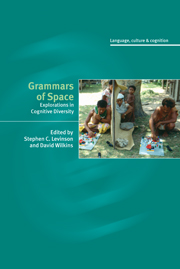Book contents
- Frontmatter
- Contents
- List of figures
- List of tables
- List of contributors
- Preface
- 1 The background to the study of the language of space
- 2 Towards an Arrernte grammar of space
- 3 Sketch of a Jaminjung grammar of space
- 4 Prolegomenon to a Warrwa grammar of space
- 5 The language of space in Yélî Dnye
- 6 Prolegomena to a Kilivila grammar of space
- 7 A sketch of the grammar of space in Tzeltal
- 8 Spatial reference in Yukatek Maya: a survey
- 9 Approaching space in Tiriyó grammar
- 10 Elements of the grammar of space in Ewe
- 11 Spatial language in Tamil
- 12 A grammar of space in Japanese
- 13 Some properties of spatial description in Dutch
- 14 Patterns in the data: towards a semantic typology of spatial description
- Appendices
- References
- Author index
- Language/Language family index
- Subject index
Preface
Published online by Cambridge University Press: 22 September 2009
- Frontmatter
- Contents
- List of figures
- List of tables
- List of contributors
- Preface
- 1 The background to the study of the language of space
- 2 Towards an Arrernte grammar of space
- 3 Sketch of a Jaminjung grammar of space
- 4 Prolegomenon to a Warrwa grammar of space
- 5 The language of space in Yélî Dnye
- 6 Prolegomena to a Kilivila grammar of space
- 7 A sketch of the grammar of space in Tzeltal
- 8 Spatial reference in Yukatek Maya: a survey
- 9 Approaching space in Tiriyó grammar
- 10 Elements of the grammar of space in Ewe
- 11 Spatial language in Tamil
- 12 A grammar of space in Japanese
- 13 Some properties of spatial description in Dutch
- 14 Patterns in the data: towards a semantic typology of spatial description
- Appendices
- References
- Author index
- Language/Language family index
- Subject index
Summary
This book is about the way languages structure the spatial domain. Spatial language is an important topic of current research, because it offers insights into a central area of human cognition. The research in this book shows that, contrary to the prevailing assumptions, there is quite unexpected variation in the conceptual structure of this central domain across languages. Semantic universals do not lie at the complex conceptual level that many linguists and psychologists had supposed, but rather at a more abstract level.
This book is designed as the companion volume to Space in language and cognition (Cambridge University Press, 2003), which is focussed on the psychology of space, and the cognitive consequences of language difference. In contrast, the present volume provides the methods, empirical materials and the wide survey of language variation which are presupposed and form the basis for the study of cognition in the companion book.
This book represents a new kind of work in linguistics, which we are calling ‘semantic typology’. Most work in typology takes some function, and asks how different languages use different formal means to satisfy this function. Instead, in this book, starting out from a functional base (centrally, how one answers ‘Where’-questions), we ask what are the semantic parameters, or semantical notions, used to structure the relevant semantic field. Such semantic parameters are reflected in both major grammatical distinctions and the structure of lexical fields.
- Type
- Chapter
- Information
- Grammars of SpaceExplorations in Cognitive Diversity, pp. xv - xviiiPublisher: Cambridge University PressPrint publication year: 2006

